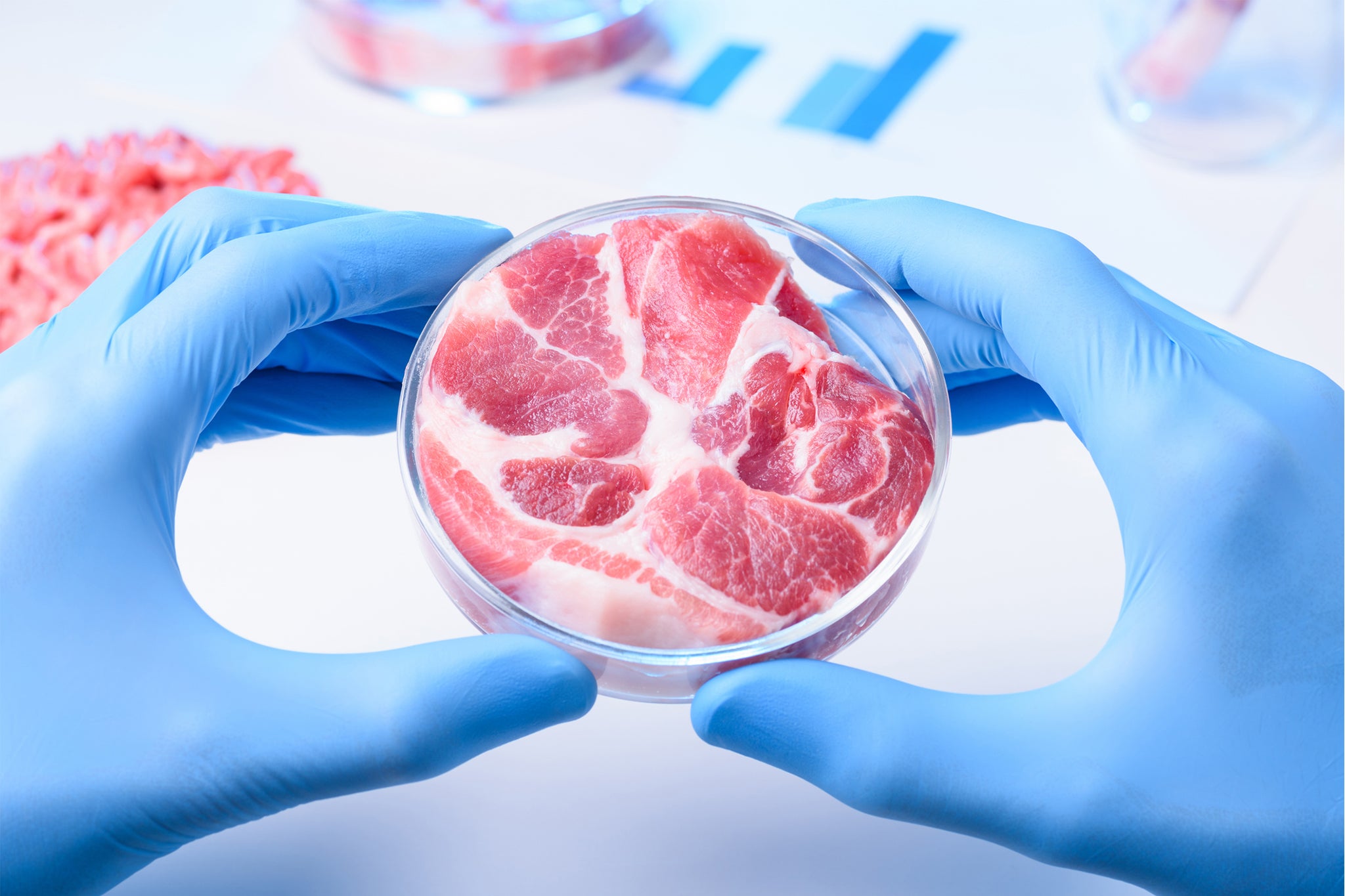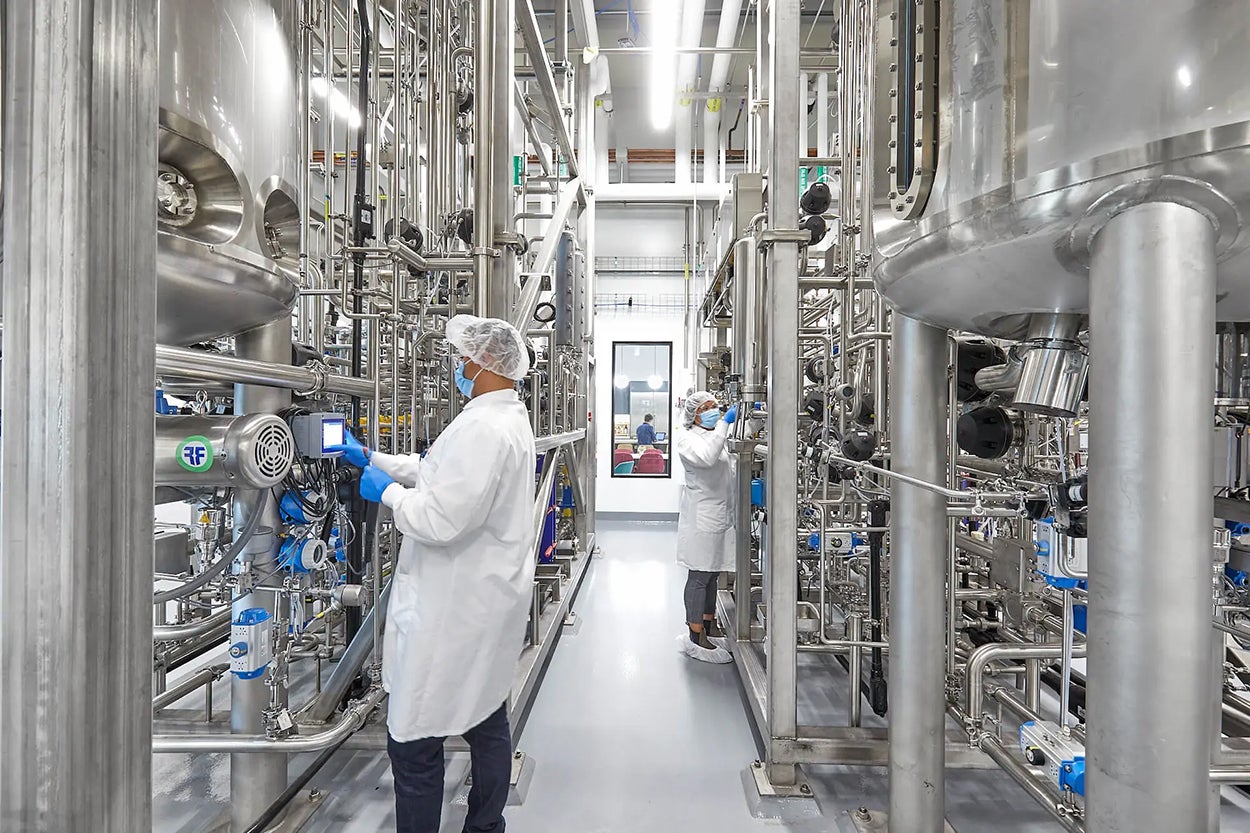Lab-grown meat: will Britain embrace food grown in a bioreactor?
The government’s betting on lab-grown meat as the future of food, but will meat harvested in a vat ever win over the public? With promises of sustainability, Hannah Twiggs wonders if sci-fi steak is really the answer or just a high-tech fix to a much bigger problem in our food chain


Last week, the UK government made headlines by granting £1.6m to the Food Standards Agency (FSA) to investigate something straight out of science fiction: lab-grown meat. The notion of beef that never chewed its cud or chicken that clucked feels like the fever dream of a Black Mirror writer.
Yet here we are, staring down the prospect of a future where meat is produced in vats, not fields. Before you start imagining petri-dish poultry and test-tube T-bones in Tesco, let’s tackle the big questions: is it safe? Is it healthy? And will it save the planet or is it just another ultra-processed foodstuff?
Upside Foods, one of the leaders in cultivated meat, certainly thinks it has a place in a sustainable food future. “We’re so past the petri dish stage,” says Melissa Musiker, the California-based company’s head of communications. Rather than a sterile, futuristic lab, think more along the lines of an artisanal brewery, but swap out the hipster hops for massive steel bioreactors.
So how does lab-grown meat come to life? It starts with cells from a fertilised chicken egg. Scientists choose the best ones, making sure they grow continuously into high-quality, safe meat. The cells are then fed a nutrient-rich broth of water, sugars, amino acids, vitamins, minerals and salts, all brewed up in those huge bioreactors. Two to three weeks later, they harvest what will eventually resemble a chicken fillet. While the concept sounds futuristic, it’s grounded in real science that has existed for years.

In fact, the origin of the idea has medical roots. Dr Uma Valeti, Upside’s founder, dreamt up the concept while he was using stem cells to help heart attack patients regrow damaged tissue. If we can regrow human organs, he thought, why not regrow meat? Fast forward more than a decade, and Upside Foods now churns out more than 22,000kg of cultivated chicken annually, with ambitions to increase that eightfold.
And it’s not alone. Other companies like Eat Just and BlueNalu are also making strides, with lab-grown chicken already available in Singapore and BlueNalu’s bluefin tuna on the horizon. The technology varies between companies – some take cells from a live animal, for example – but the UK remains behind, thanks to regulatory hurdles. The recent FSA funding is a critical step in laying out the groundwork to bring cultivated meat to British plates.
The real question, though, is whether this high-tech meat offers meaningful improvements on the conventional stuff. Tim Spector, professor of genetic epidemiology at King’s College London and a heavy hitter in the UK’s food-health scene, sees it as an essential stepping stone to get people to rethink their diets. “In a way, for many people, this might be a transition. We need to get them onto plants,” he says.
Spector doesn’t deal in absolutes; he’s more interested in the grey areas, in incremental gains. Take the backlash against Beyond Meat and Impossible Burgers, plant-based meat products – also produced in a lab – that were criticised for being ultra-processed, “but they’re still healthier than the burgers they were replacing”, he says. The point isn’t perfection but progress, and that’s exactly what lab-grown meat offers – a step away from industrialised meat production.

Then there’s the issue of whether lab-grown meat can be classed as ultra-processed. “Lab-based meat itself is quite basic,” Spector says. “To give it the texture and feel of real meat, you might have to add chemicals that could make it ultra-processed, but that doesn’t have to be the case.” Protein and fat aren’t inherently processed, he points out. It’s what happens to them next – how they’re manipulated – that could push lab-grown meat into the ultra-processed category.
Still, while the potential benefits of lab-grown meat are significant, not everyone is convinced that technology is the answer. Patrick Holden, a dairy farmer and founder of the Sustainable Food Trust, is particularly sceptical. “I think it’s sad that so much energy and attention is being focused on reinventing nature when nature would always do a much better job than tech at feeding us,” he says.
Holden advocates for regenerative farming practices that work with nature rather than trying to outsmart it in a lab. On his farm, he focuses on improving soil health, sequestering carbon and enhancing biodiversity by rotating crops and grazing animals on natural pastures.
This, he believes, is the real solution. However, these methods remain on the fringes of British farming. Holden says the real issue is industrial farming’s grip on the UK. “Everybody’s saying, ‘Oh, we have to give up meat, we have to go on a plant-based diet.’ Well, no. We need to give up eating cheap, industrial white meat like chicken.” As he puts it, “It’s not the cow, but the how.”

Beyond environmental concerns, Holden also wonders whether meat from a bioreactor can ever capture the richness and complexity of something produced naturally. “How are they going to mimic that in a lab?” he asks. The cheese he makes on his farm reflects the diversity of the pastures his cows grace on. That kind of terroir, he argues, can’t be grown in a vat.
Musiker, for her part, laughs off these criticisms. She argues that it’s precisely because Upside’s chicken isn’t grown on a living, flapping bird that it’s so tender. With the tension of movement, the meat is softer. She recently hosted a dinner where Upside chicken was on the menu, and it was so close to the real thing that her neighbours complained about the smell. “Which is just a really big compliment for us,” she laughs. She’s even convinced friends who gave up meat for ethical reasons. “One had tears in her eyes. She hadn’t eaten a piece of meat in 20 years. She thought it was uncanny.”
For Upside, the real target isn’t small-scale, sustainable farms. It’s the vast industrial meat complex responsible for a sizeable chunk of global greenhouse gas emissions. “Somehow we are seen as an existential threat when we’re producing a fraction of a fraction of a percentage of the overall animal agricultural industry,” she says. When in reality, “if you’re into slow food and small farms or regenerative agriculture, your end goal is very similar to our end goal.”
That is, to reduce demand for cheap, mass-produced meat driving deforestation, water depletion and pollution. She describes cultivated meat as an “environmental release valve”, an option for people “who are trying to actualise their climate angst”, much like buying an electric car or offsetting their carbon emissions when they fly.
I think it’s sad that so much energy and attention is being focused on reinventing nature, when nature would always do a much better job than tech at feeding us
But is it really better for the planet? Traditional meat production is undeniably a heavy hitter when it comes to global emissions. Raising animals requires land, water and feed, while generating significant methane. Research suggests lab-grown meat could cut greenhouse gas emissions by up to 96 per cent compared to conventional meat production, while using far less land and water.
However, it’s not entirely free of challenges. It requires a significant amount of energy, particularly in the form of electricity to power those enormous bioreactors. For now, we’re talking about kilograms. Until the industry scales up, we won’t know the true environmental impact.
Cost is another hurdle. At present, lab-grown meat is expensive to produce, pricing it out of reach for all but the most eco-conscious elite. As the technology advances – thanks to funding grants like in the UK – and more companies enter the market, prices may drop, making it more accessible to the average consumer. But for now, it remains a niche product.
For all the hurdles, Spector remains optimistic. “I’m all for these foods,” he says. “Generally, it’s moving people in the right direction and the foods are getting either more sustainable or more healthy.” In 10 years, he predicts, “we will all be eating this stuff”. And in the meantime, it’s a good thing we’re having the conversation. “How much meat you eat is the most important decision you can make for the planet,” he says.

But for all the optimism from Upside Foods, lab-grown meat faces significant hurdles before it can become mainstream. Regulation is the first obstacle; misinformation is another. Some people question whether it qualifies as “healthy” in the broader sense.
Last year, a now-debunked article on Bloomberg raised concerns about the cells used to produce lab-grown meat, speculating their rapid growth might make them precancerous. While the claim has been thoroughly discredited, it highlights the public’s hesitation about this new technology. That said, lab-grown meat comes with certain advantages: it’s free from antibiotics, hormones and the environmental risks of conventional farming, like avian flu.
Musiker is confident that, over time, these reservations will fade. She compares the current scepticism to the early days of other groundbreaking technologies. “It’s like that famous 1994 segment on the Today show where Katie Couric and Bryant Gumbel asked, ‘What is internet, anyway? Do you write to it, like mail?’ It took years, but now it’s ubiquitous.”
Will the same be true for lab-grown meat? That remains to be seen. For now, it’s a work in progress with regulatory hurdles to clear and production costs to reduce. But with the UK government now on board, the possibility of cultivated meat becoming a fixture in British supermarkets is no longer far-fetched.
Ultimately, lab-grown meat presents both a promise and a dilemma. It offers a high-tech solution to some of the most pressing issues facing the food system – from climate change to animal welfare – but it also raises fundamental questions about the role of technology in our food supply. Is it a stepping stone to a more sustainable future, or a distraction from the more natural solutions that already exist? The answer may depend on how willing we are to embrace a future where meat no longer comes from an animal at all.






Join our commenting forum
Join thought-provoking conversations, follow other Independent readers and see their replies
Comments